
| Palaeos: |  |
Glossary |
| The Vertebrates | Q-R |
| Page Back | Unit Back | Unit Home | Unit Dendrogram | Unit References | Glossary | Taxon Index |
| Page Next | Unit Next | Vertebrates Home | Vertebrate Dendrograms | Vertebrate References | Bones | Time |
For most phrases beginning with directional words, e.g. "posterior," "dorsal," "external," etc., or some generic anatomical terms, e.g., "vena," look under the next word in the phrase. However, note that this convention is not used with complete consistency in this Glossary.
Quadrate: [1] In tetrapod osteology, the quadrate lies at the posteroventral corners of the skull and forms the jaw joint (except in mammaliforms). In the Sauria, it is often the main "pillar" supporting the skull table and the occiput, and its anterolateral border provides the surface for attachment of the tympanum. [2] In mammalian dentition, quadrate means [2a] four-sided and having sharp corners or, [2b] in describing one or more corners of a tooth, sharp corners of about 90°. In addition, [2c] when a molar is described as "quadrate" the author usually means that the four main cusps are of roughly equal height, and the trigonid is not markedly elevated with respect to the talonid. The primate molar is perhaps the morphotype one should have in mind.
Quadrate ramus: of the pterygoid. This is the part of the pterygoid (often the largest and most central bone of the palate) which emerges from the body of the pterygoid, where it participates in the articulation with the braincase (the basicranial articulation), if present, and the epipterygoid articulation (if present). The quadrate ramus then runs posteriorly, laterally and often ventrally to reach the quadrate. Thus, it parallels the course of the original palatoquadrate unit and may have been derived from a dermal bone sheathing the posteromedial surface of the palatoquadrate -- much as the maxilla began as dermal bone sheathing the anterolateral portion of the palatoquadrate. The geometry of the quadrate ramus is extraordinarily complex and usually involves tortion and bending. That is, the quadrate ramus begins as a horizontal strip of bone running back from the center of the palate. It bends downward and twists as it approaches the quadrate so that, by the time it articulates with the quadrate, it is a vertical strip of bone with its formerly dorsal surface now facing laterally (outwards).
Rachis: (pl. raches) the central stem of a feather.
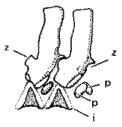 Rachitomous:
a condition in which the various elements of the vertebrae are divided into a
large, wedge-shaped intercentrum plus two pleurocentra (smaller, intersegmental
pieces). A type of aspidospondyly.
See also figure and note under Anthracosauroidea.
Rachitomous:
a condition in which the various elements of the vertebrae are divided into a
large, wedge-shaped intercentrum plus two pleurocentra (smaller, intersegmental
pieces). A type of aspidospondyly.
See also figure and note under Anthracosauroidea.
Radial: (a) direction away from imaginary axis running antero-posteriorly through the middle of the organism or structure; peripheral. Opposite of axial. (b) one of a series of bones (preaxial or postaxial) branching from the mesomeres of sarcopterygian pectoral fins. See figure at Dipnomorpha.
Radiale: one of the proximal carpal bones of the wrist. See figure at carpus.
Ramiform: branch-like; alternatively, branching or having branches. This is a slippery word and tends to get used improperly as a synonym for straight or rod-like.
Ramus (pl. rami): branch. The word is typically used in a sense synonymous with process. Perhaps the word might better be confined to cases in which a bone or other structure actually appears to splits into two or more parts, as this is the sense in Latin.
Rastrate: rake-like.
Rathke's Pouch: an embryonic invagination of the stomodeal ectoderm (i.e. the roof of the embryonic mouth) which migrates dorsally to come into contact with the diencephalon (the posterior section of the forebrain). This differentiates into the anterior pituitary gland or adenohypophysis. The tube thus formed between the mouth and pituitary is pinched off in most higher vertebrates. However in at least some non-gnathostomes, it develops into a blind naso-hypophyseal canal or may develop a secondary opening to the environment, with or without a connection to the oralopharyngeal cavity (mouth). See The Basisphenoid. Note that this is not the same developmental process which forms the nasal cavity. Other than an initial depression at the nasal placodes, the nasal cavity, at least in mammals, is apparently formed by partition of the stomodeum.
Recessus conicalis: any conical recess. In certain anseriforms, "a deep conical hollow extending on the medial side from the retroarticular process [of the articular] anteriorly under the articulation." Olson (1999).
Recessus scala tympani: the recessus scala tympani and recessus scala vestibuli are created by the subdivision of the inner ear. The two recessi are the osteological correlates in reptiles of the scala tympani and scala vestibuli, respectively. See the inner ear in reptiles for an explanation in English.
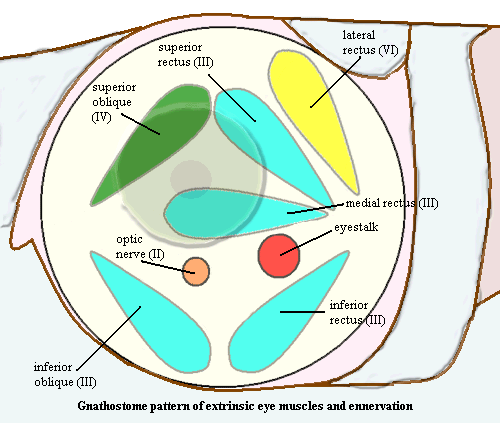 Rectus
muscles: the posterior extrinsic eye muscles. See discussion and
additional figures of the gnathostome
orbit.
Rectus
muscles: the posterior extrinsic eye muscles. See discussion and
additional figures of the gnathostome
orbit.
Red Bay Group: Silurian-Devonian of Spitzbergen. Blom & Goujet (2002).
Red Bed: a term applied to sedimentary sequences which are predominantly red in color but usually associated with variable proportions of interdigitated drab strata, typically grey, grey-green, brown or black. They comprise a wide range of facies representing the whole spectrum of non-marine depositional environments from alluvial fans, river floodplains, deserts, lakes and deltas and range in age from Early Proterozoic to Cenozoic. STRATIGRAPHY AND SEDIMENTOLOGY OF CONTINENTAL RED BEDS Peter ....
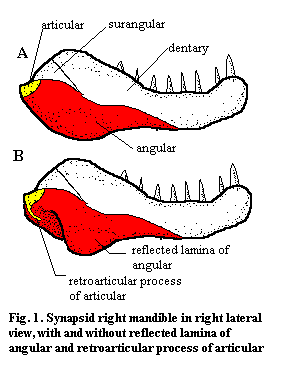 Reflected
lamina: used of several bone processes where the bone appears to split
into two "mirror image" processes. Most commonly refers to the
synapsid reflected lamina of the angular. See figure with reflected lamina of
angular.
Reflected
lamina: used of several bone processes where the bone appears to split
into two "mirror image" processes. Most commonly refers to the
synapsid reflected lamina of the angular. See figure with reflected lamina of
angular.
Regression: period of low sea level when previously marine sediments are exposed. Opposite of transgression.
Reichert's cartilage: in mammals, the embryonic precursor of the tympanohyal.
Reissner's membrane: the membrane of the cochlea separating the scala media from the scala vestibuli. See the Ear
Remix: (pl. remiges) the principle flight feathers, including primaries and secondaries.
Reniform: shaped like a kidney.
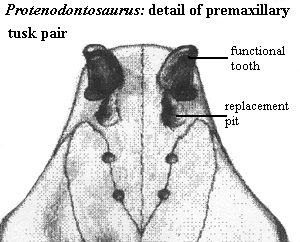 Replacement
pit: a pit paired with a tooth alveolus and joined to it by a
channel. The replacement tooth grows in the pit and migrates to the
alveolus as it matures. See image at left from Nosotti & Pinna (1999)
Replacement
pit: a pit paired with a tooth alveolus and joined to it by a
channel. The replacement tooth grows in the pit and migrates to the
alveolus as it matures. See image at left from Nosotti & Pinna (1999)
Reptilian jaw: a jaw with an articular-quadrate articulation, as opposed to the mammalian dentary-squamosal articulation.
Reticulate: as an adjective, net-like. A reticulate pattern may be used to describe a network of raised lines creating a web-like pattern. Sometimes used generally as meaning complex & interdependent.
Reticulum: the second chamber of the ruminant digestive tract, used for sorting out fine plant particles for further fermentation. See Artiodactyla for figure.
Retraction: in tetrapod locomotion, rotation of a limb posteriorly, in a horizontal plane. Opposite of protraction; and in contrast to adduction or abduction (movement in a vertical plane) or rotation about the long axis of a limb. C.f. Humerus.
Retrix: (pl. retrices) a tail feather.
Retroarticular (bone): in Actinistia, Meckel's cartilage ossifies posteriorly in two places. The more anterior of these is the usual articular bone. However, a second ossification occurs posterior to this, creating a separate retroarticular bone which receives the symplectic (which, in turn, is ultimately connected to the hyomandibular). In adults, the retroarticular and articular may fuse, but development is probably always from two separate centers of ossification.
Retroarticular process: a posterior process which despite the name, may be composed of any combination of the articular, angular, and surangular, projecting behind the glenoid. See image at reflected lamina for one example. Perhaps a more typical retroarticular process is the usual archosaur process. This type of retroarticular process is more blunt, fairly massive, and projects posteromedially (and often somewhat dorsally). The retroarticular process initially evolved in the elpistostegalian lineage (tetrapod stem group) as an attachment point for the depressor mandibulae. The evolution of this muscle is correlated with the loss of the opercular complex, since the jaw depressor originates on the hyoid arch. The thought seems to be that the hyoid would not have been available to anchor the depressor if it were still coupled to the opercular apparatus. Ahlberg et al. (2005).
Revolute: permitting only rotation in one plane. Thus a revolute joint is a joint which permits rotational motion (but not translation) only in one plane.
Rhaetian Age: the last Age of the Triassic Period, 210-206 Mya.
Rhachitomous: having vertebrae with a large, dorsal, crescentic intercentrum and a small, dorsal, paired pleurocentrum.
Rhamphotheca: The hardened keratinous beak of a turtle, bird, anomodont, trilophosaur, etc.
Rhinarium: an area of moist, hairless skin surrounding the nostrils of primates.
Rhino-: Greek root = "nose".
Rhomboid: diamond-shaped, i.e., trapezoidal with sides of roughly equal length.
Rhynchokinetic: having the ability to flex the upper jaw independently. Usually applied to birds which raise the upper jaw by moving the quadrate forward. This motion is translated and amplified into an upward movement of the upper jaw through the jugal + quadratojugal and the pterygoid + palatine. Think of it as a sneer involving the whole upper jaw.
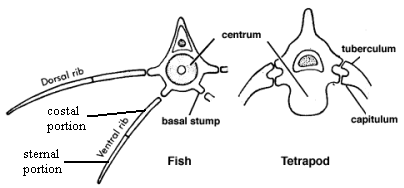 Ribs:
Ribs are endochondral bone. They are preformed in cartilage which develops from
the membranes separating muscle blocks (myosepta). There are two kinds: Dorsal
ribs (intermuscular ribs) ribs occur at the junction of myosepta and
the horizontal septum, separating the epaxial from hypaxial muscles. Ventral
ribs (subperitoneal or pleural ribs) ribs are found in the junction
of myosepta and the peritoneum, next to the body cavity. Ventral ribs appear to
be serially homologous with the hemal arches of the caudal vertebrae. Lampreys
and hagfish have no ribs; elasmobranchs have short, ventral ribs, and
holocephalians have none. Polypterus and some teleosts have dorsal and
ventral ribs. Other fishes have only ventral ribs. The ribs of tetrapods are
thought to be dorsal ribs. The earliest fossil tetrapods had bicipital
(two-headed) ribs, with a tuberculum that articulates with the diapophysis, and
a capitulum articulating with the intercentrum. Many living tetrapods have
unicapitate (one-headed) ribs. The ribs of the thorax region in amniotes have a
dorsal, ossified costal portion, and a usually cartilaginous sternal part. True
ribs articulate with the sternum; false ribs articulate with each other, but not
the sternum. Modified from Axial Skeleton.
Image from BIO 342.
Ribs:
Ribs are endochondral bone. They are preformed in cartilage which develops from
the membranes separating muscle blocks (myosepta). There are two kinds: Dorsal
ribs (intermuscular ribs) ribs occur at the junction of myosepta and
the horizontal septum, separating the epaxial from hypaxial muscles. Ventral
ribs (subperitoneal or pleural ribs) ribs are found in the junction
of myosepta and the peritoneum, next to the body cavity. Ventral ribs appear to
be serially homologous with the hemal arches of the caudal vertebrae. Lampreys
and hagfish have no ribs; elasmobranchs have short, ventral ribs, and
holocephalians have none. Polypterus and some teleosts have dorsal and
ventral ribs. Other fishes have only ventral ribs. The ribs of tetrapods are
thought to be dorsal ribs. The earliest fossil tetrapods had bicipital
(two-headed) ribs, with a tuberculum that articulates with the diapophysis, and
a capitulum articulating with the intercentrum. Many living tetrapods have
unicapitate (one-headed) ribs. The ribs of the thorax region in amniotes have a
dorsal, ossified costal portion, and a usually cartilaginous sternal part. True
ribs articulate with the sternum; false ribs articulate with each other, but not
the sternum. Modified from Axial Skeleton.
Image from BIO 342.
Riochican Age: South American Land Mammal Age corresponding to the Late Paleocene.
Ricochetal: jumping locomotion in the time-honored zigzag pattern of rabbits and some kangaroos.
Río Neuquén Formation: Late Cretaceous (Turonian) of Argentina. Patagonykus.
Riochican: South American Land Mammal Age (q.v.) roughly equivalent to the Late Paleocene.
Roadkill view: an orientation in which the torso is shown dorsally, with the limbs sticking straight out to the sides. The fine points are discussed in connection with the Humerus.
Rostral: (1) Relating to the rostrum. (2) Towards the rostrum. Normally synonymous with "anterior," but not always. In discussing features of the human head, for example, "anterior" is ambiguous and "cephalad" (towards the head) is meaningless, so "rostral" is used instead. I am unsure what the opposite direction is. I've seen "caudal" used, but that's senseless as well as ambiguous. "Rostral" is reserved for head structures, and there is no tail (L. cauda = tail) on the head. "Occipital" or "nuchal" might be better, but I have not seen them used in that fashion.
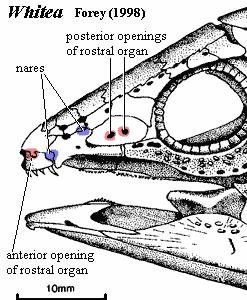 Rostral
organ: in Actinistia,
a presumably sensory structure located in the rostrum, dorsomedial to the nasal
capsules. The rostral organ has paired anterior openings anterior to the
anterior nares, and two pairs of posterior foramina posterior to the posterior
nares. In Latimeria, the organ is filled with a gel of unknown
composition. The rostral organ may have an electrosensory
function.
Rostral
organ: in Actinistia,
a presumably sensory structure located in the rostrum, dorsomedial to the nasal
capsules. The rostral organ has paired anterior openings anterior to the
anterior nares, and two pairs of posterior foramina posterior to the posterior
nares. In Latimeria, the organ is filled with a gel of unknown
composition. The rostral organ may have an electrosensory
function.
Rostral tubules: in dipnomorph sarcopterygians, "a network of branching canals ... which are interpreted as transmitting either nerve fibers to sensory organs on the surface ... or capillary blood vessels." Janvier (1996: 200)
 Rostropterygoid
articulation: in some birds, a state in which the pterygoids, rather than
articulating with the basipterygoid processes of the basisphenoid, articulate
with the parasphenoid only. There is some doubt whether this state
actually exists as a separate phenotype. Apparently, the pterygoids normally
articulate with the parasphenoid to some degree. Thus the
"rostropterygoid articulation" may be no more than the absence of a
basipterygoid articulation. See Ericson
(1997) (expressing doubt).
Rostropterygoid
articulation: in some birds, a state in which the pterygoids, rather than
articulating with the basipterygoid processes of the basisphenoid, articulate
with the parasphenoid only. There is some doubt whether this state
actually exists as a separate phenotype. Apparently, the pterygoids normally
articulate with the parasphenoid to some degree. Thus the
"rostropterygoid articulation" may be no more than the absence of a
basipterygoid articulation. See Ericson
(1997) (expressing doubt).
Rostrum (pl.: rostra): (1) in early vertebrates, an anterior medial projection of hard tissue from the head, normally containing the mouth (2) an anterior medial bone of the skull which forms part of the muzzle or rostrum.
Round window: same as fenestra rotunda or fenestra cochleae.
Rugose: roughened. The implication of a rugose bone is normally that it served as a surface for muscle or tendon attachment. Another possibility is that the bone was extended in cartilage.
Rumen: the first chamber of the ruminant digestive tract, used for storage of ingested food and initial digestion of proteins and simple carbohydrates. See Artiodactyla for figure.
Ruminant: an herbivore which uses gastric, as opposed to intestinal, fermentation to digest cellulose. See Artiodactyla for figure and further explanation.
| Page Back | Unit Home | Page Top | Page Next |
checked ATW060208